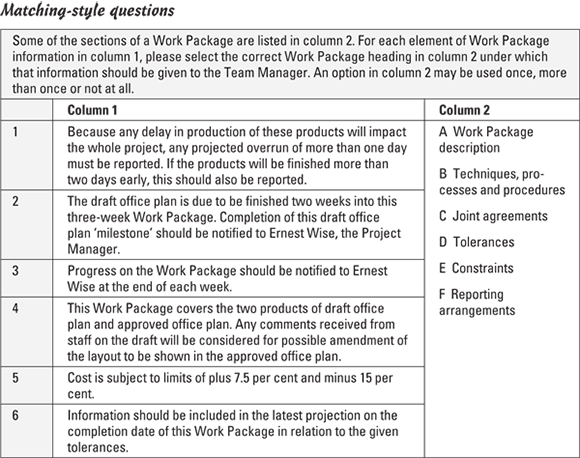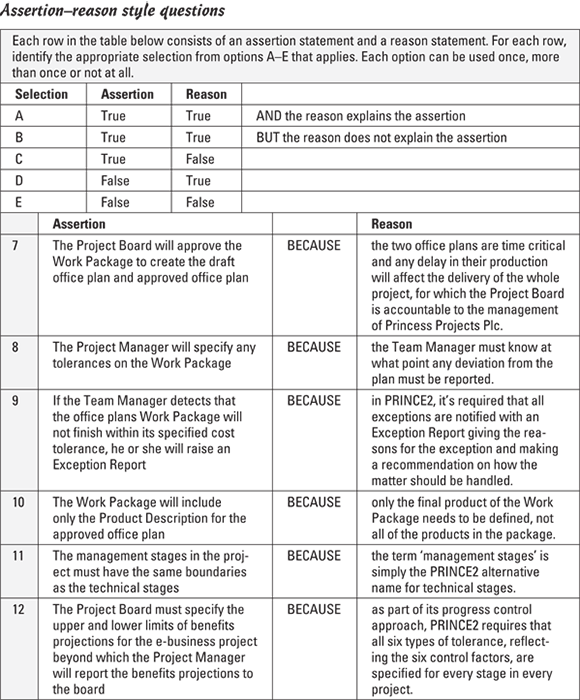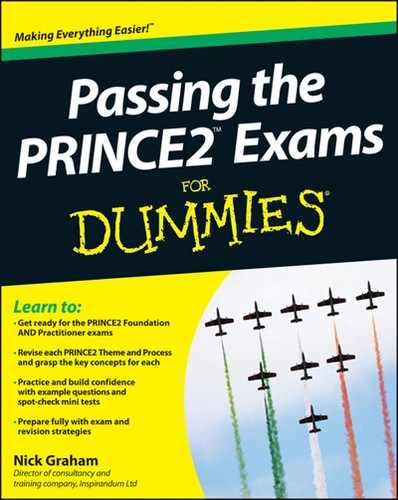Practising With Some Questions
To test your knowledge of the Progress theme, have a go with some practice questions. This section has Foundation- and Practitioner-level questions, and you’ll find the answers, together with a bit of explanation, at the end of the chapter.
Foundation-level questions
To get used to the pace of the Foundation exam, try to see these questions off in eight minutes.
1. What’s the major control in PRINCE2 that means that the Project Board doesn’t have to authorise all of the money and staff resource for the project in one go?
![]() a) Work Package
a) Work Package
![]() b) Management stages
b) Management stages
![]() c) Project Initiation Documentation (PID)
c) Project Initiation Documentation (PID)
![]() d) Technical stages
d) Technical stages
2. A management stage is:
![]() a) The time needed to produce a Work Package
a) The time needed to produce a Work Package
![]() b) A financial period (monthly, quarterly or annual) defined by corporate or programme management
b) A financial period (monthly, quarterly or annual) defined by corporate or programme management
![]() c) A collection of activities and products whose delivery is managed as a unit by the Project Manager on behalf of the Project Board
c) A collection of activities and products whose delivery is managed as a unit by the Project Manager on behalf of the Project Board
![]() d) The PRINCE2 term for a technical stage
d) The PRINCE2 term for a technical stage
3. Progress is measured in the context of six control factors. Five of them are time, cost, quality, scope and benefits. Which is the sixth factor?
![]() a) Risk
a) Risk
![]() b) Performance
b) Performance
![]() c) Economy
c) Economy
![]() d) Environmental impact
d) Environmental impact
4. At which management level(s) can tolerance be specified?
![]() a) Project level
a) Project level
![]() b) Stage level
b) Stage level
![]() c) Work Package level
c) Work Package level
![]() d) All of the above
d) All of the above
5. Which of these is an influence on the Project Board’s decision on the number of management stages in a project?
![]() a) The complexity of the configuration management
a) The complexity of the configuration management
![]() b) The level of risk
b) The level of risk
![]() c) The number of Team Managers
c) The number of Team Managers
![]() d) The number on a dice thrown by the Executive
d) The number on a dice thrown by the Executive
6. What’s the minimum number of management stages in a PRINCE2 project that goes through to its planned completion?
![]() a) One: a single delivery stage in a simple project that needs little or no planning
a) One: a single delivery stage in a simple project that needs little or no planning
![]() b) Two: Initiation and at least one delivery stage
b) Two: Initiation and at least one delivery stage
![]() c) Three: Start Up, Initiation and at least one delivery stage
c) Three: Start Up, Initiation and at least one delivery stage
![]() d) Four: Start Up, Initiation, at least one delivery stage then closure
d) Four: Start Up, Initiation, at least one delivery stage then closure
7. PRINCE2 uses two types of control. One is time-driven controls, what’s the other?
![]() a) Ad-hoc controls specified by the Project Board
a) Ad-hoc controls specified by the Project Board
![]() b) Financial controls specified by corporate or programme management
b) Financial controls specified by corporate or programme management
![]() c) Delivery-based controls using key products
c) Delivery-based controls using key products
![]() d) Event-driven controls
d) Event-driven controls
8. Tolerances on the project are set by:
![]() a) Corporate or programme management
a) Corporate or programme management
![]() b) The Project Board
b) The Project Board
![]() c) The Project Manager
c) The Project Manager
![]() d) Project Assurance
d) Project Assurance
9. Which of the following is not one of the tolerances used within PRINCE2?
![]() a) Cost
a) Cost
![]() b) Time
b) Time
![]() c) Productivity
c) Productivity
![]() d) Benefits
d) Benefits
10. What would the Project Board do if a stage level Exception Plan had been produced?
![]() a) Do nothing, because it’s within the delegated authority of the Project Manager.
a) Do nothing, because it’s within the delegated authority of the Project Manager.
![]() b) Hold a meeting (Exception Assessment) to consider and approve the plan.
b) Hold a meeting (Exception Assessment) to consider and approve the plan.
![]() c) Refer the plan to corporate or programme management for approval.
c) Refer the plan to corporate or programme management for approval.
![]() d) Declare an exception.
d) Declare an exception.
Practitioner-level questions
After reading the additional scenario, try to answer the 12 questions in 18 minutes. It really helps to work to the same pace that you’ll need for the exam.
Additional project scenario
One Work Package in the project is to produce the draft office plan and the approved office plan. These are vital for the project and will show the layout of the four rooms in the e-business unit, including such things as electrical sockets, phone points and new doorways. These two products will be the first to be created in the project. The products are critical because if this Work Package is delayed, the product dependencies are such that the rest of the project will also be delayed.
You should use this information in this section, along with the main scenario information at the end of Chapter 2.


Answers to the Foundation-level questions
1. b. You can’t think ‘control’ within PRINCE2 without immediately thinking ‘management stages’. They’re the big Project Board control.
2. c. The management stage is a block of work that the Project Board is willing to delegate to the Project Manager to be done in one go.
3. a. It’s about rote-learning the six control factors, and there’s no short cut to that.
4. d. Tolerance can be set at different levels, so don’t get locked into stage-level tolerance.
5. b. In reality there are quite a few factors, but the PRINCE2 manual is very narrow and refers specifically to just four, one of which is the level of risk. [Manual 10.3.2.2]. By the way, answer ‘d’ was intended as a joke and to provide some light relief in your revision, but if you didn’t realise that then I worry about your organisation’s projects. Sadly there are no signs of humanity in the Foundation exam now, but in the good old days there used to be a couple of questions in the pool with a tinge of humour in them.
6. b. Remember, Start Up isn’t a stage – it happens before the project and so pre-dates the project stages, and the project may not have a closure stage.
7. d. Event-driven controls, which include things like end stage and exception. These kick in when the relevant event occurs.
8. a. Remember, tolerance is set by the level above. It’s a common error to think that project tolerance is set by the Project Board.
9. c. Tolerances relate to the six control factors: costs, timescales, quality, scope, risk, benefits. [Manual 1.5.2, P2FD Chapter 2 Appreciating the Six Control Variables]
10. b. Although the name ‘Exception Assessment’ is hard to find in the manual. [Manual Glossary]
Answers to the Practitioner-level questions
The Practitioner practice questions in this chapter are mostly centred on the Work Package, although this brings in other elements of the Progress theme, such as exception management. In the exam, if you see a block of questions focused on a particular management product, it pays to flip your manual open to the relevant page in Appendix A immediately, before you tackle those questions. The product details are then in front of you. Otherwise, when you’re deep in the section and dealing with a minor point, you may be tempted to try to remember what’s in the product, with the possibility that you’ll get it wrong. But if you’ve already opened the manual at the page, you can take a mere moment to glance at it and make sure of the mark.
1. D. Tolerances are the limits which define the delegated authority of the person receiving the work which in this case is a Work Package. Tolerances always specify an upper and lower limit.
2. C. The joint agreement specifies key milestones.
3. F. The requirement for progress reporting using the Checkpoint Report.
4. A.
5. D. Tolerances again, this time on cost. Remember, an option in column 2 may be the answer to more than one question.
6. F. Reporting requirements again. This answer ‘F’ is to hammer home the point that an option in column 2 can be the answer to more than one question and, because this is the last question in the panel, you can also see that some of the options in column 2 weren’t needed at all. Don’t make the mistake of thinking that these questions are like children’s puzzles where you draw lines from one side to the other and every question on the left-hand side has a corresponding and different answer on the right-hand side so that all the answer options are used.
Assertion–reason style questions
If you were confused by the assertion–reason style (and many people find it tricky), do have a look at Chapter 2. There’s help in that chapter for understanding all of the question styles, and for assertion–reason there’s a simple three-step approach.
7. D. The Project Board is not involved in approving individual Work Packages. As a job it’s too low-level, being down in the depths of the process of Controlling a Stage, the delegated work of the Project Manager.
8. A. Yes, tolerance is set by the level above, and the person doing the work must know the limits of his or her delegated authority to control that work. So, the assertion statement on the left is correct because of the reason given on the right.
9. E. Be careful if your organisation is still using an earlier version of PRINCE2, because the use of Exception Reports at the different management levels has yo-yoed between different versions. In the 2009 edition, the Exception Report is only used by the Project Manager, and then only to report a stage level exception. A Work Package exception is notified using an issue unless the Project Manager has specified an alternative procedure. The Executive reports a project exception to programme or corporate management, as instructed, but that’s beyond the project now and so outside the scope of PRINCE2.
10. E. The Product Descriptions of all products included in the Work Package should be included. The Product Description contains vital information not only to define the products, but also to give information on how they’re to be tested. It’s not down to Team Managers to re-invent some of the products in the Work Package.
11. E. The names ‘management stage’ and ‘technical stage’ are not interchangeable. Some management stage boundaries may be aligned with technical stage boundaries, but it isn’t mandatory that all of them are. It’s important in this question to notice the word ‘must’ in the assertion statement. [P2FD Ch17 Thinking ‘management’ stages not ‘technical’ in the section ‘Controlling the project with stages’]
12. E. The assertion statement refers to project tolerance not stage tolerance. Take care to read questions in the exam very carefully and take on board every word, and not least as you approach the end of a section when you may be under a bit of time pressure. Project tolerances, including one on benefits if it’s been set, are specified by the level above, which is corporate or programme management. Notice too that this is the fourth occurrence of ‘E’ as a correct answer. That’s unlikely in the exam, but is here to emphasise that you need to focus on determining the correct answer from your knowledge of PRINCE2, not by trying to second-guess the probability of correct answers from the structure of the paper.
Finally, this selection of Practitioner questions mostly covers the Work Package, because it gives a good example of product-oriented questions, which in turn bring in other elements such as exception management. Don’t forget to cover all aspects of the theme in your revision, though, as set down in the checklists near the start of this chapter.
